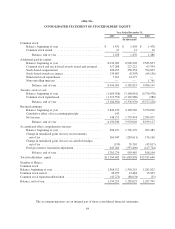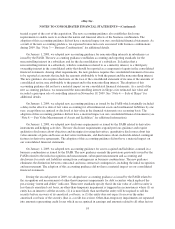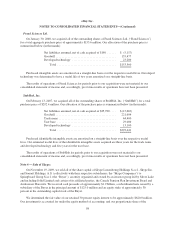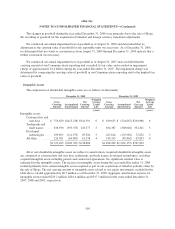eBay 2009 Annual Report Download - page 102
Download and view the complete annual report
Please find page 102 of the 2009 eBay annual report below. You can navigate through the pages in the report by either clicking on the pages listed below, or by using the keyword search tool below to find specific information within the annual report.eBay Inc.
NOTES TO CONSOLIDATED FINANCIAL STATEMENTS—(Continued)
which are recognized in other comprehensive income (loss). The adoption of the this accounting guidance did not
have a material impact on our consolidated financial statements.
During the second quarter of 2009, we adopted new accounting guidance for the determination of the useful
life of intangible assets as issued by the FASB. The new guidance amends the factors that should be considered
in developing the renewal or extension assumptions used to determine the useful life of a recognized intangible
asset. The new guidance also requires expanded disclosure regarding the determination of intangible asset useful
lives. The adoption of this accounting guidance did not have a material impact on our consolidated financial
statements.
During the second quarter of 2009, we adopted new accounting guidance related to subsequent events as
issued by the FASB. The new requirement establishes the accounting for and disclosure of events that occur after
the balance sheet date but before financial statements are issued or are available to be issued. It requires the
disclosure of the date through which an entity has evaluated subsequent events and the basis for that date, that is,
whether that date represents the date the financial statements were issued or were available to be issued. See
“Principles of consolidation and basis of presentation” included above in this “Note 1 — The Company and
Summary of Significant Accounting Policies” for the related disclosure. The adoption of this accounting
guidance did not have a material impact on our consolidated financial statements.
During the third quarter of 2009, we adopted the new Accounting Standards Codification (ASC) as issued
by the FASB. The ASC has become the source of authoritative U.S. generally accepted accounting principles
(GAAP) recognized by the FASB to be applied by nongovernmental entities. The ASC is not intended to change
or alter existing GAAP. The adoption of the ASC did not have a material impact on our consolidated financial
statements.
In June 2009, the FASB issued new accounting guidance which amends the evaluation criteria to identify
the primary beneficiary of a variable interest entity (VIE) and requires ongoing reassessment of whether an
enterprise is the primary beneficiary of the VIE. The new guidance significantly changes the consolidation rules
for VIEs including the consolidation of common structures, such as joint ventures, equity method investments
and collaboration arrangements. The guidance is applicable to all new and existing VIEs. The provisions of this
new accounting guidance is effective for interim and annual reporting periods ending after November 15, 2009
and will become effective for us beginning in the first quarter of 2010. We are currently evaluating the impact of
this accounting guidance on our consolidated financial statements.
In September 2009, the FASB issued new accounting guidance related to the revenue recognition of
multiple element arrangements. The new guidance states that if vendor specific objective evidence or third party
evidence for deliverables in an arrangement cannot be determined, companies will be required to develop a best
estimate of the selling price to separate deliverables and allocate arrangement consideration using the relative
selling price method. The accounting guidance will be applied prospectively and will become effective during the
first quarter of 2011. Early adoption is allowed. We will adopt this guidance beginning January 1, 2010 and we
do not expect this accounting guidance to materially impact our financial statements.
In September 2009, the FASB issued new accounting guidance related to certain revenue arrangements that
include software elements. The new guidance is to be applied on a prospective basis for revenue arrangements
entered into or materially modified in fiscal years beginning on or after June 15, 2010, with earlier application
permitted. If a vendor elects earlier application and the first reporting period of adoption is not the first reporting
period in the vendor’s fiscal year, the guidance must be applied through retrospective application from the
beginning of the vendor’s fiscal year and the vendor must disclose the effect of the change to those previously
reported periods. We will adopt this guidance beginning January 1, 2010. The adoption of this accounting
guidance will not have an impact on our consolidated financial statements.
94
























